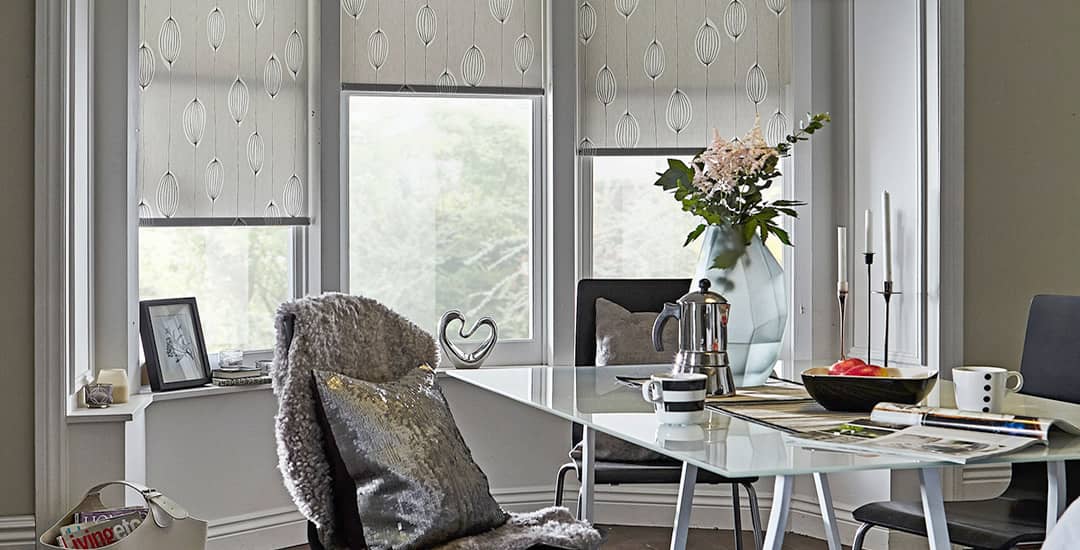
What blinds are best for a bay window? There’s a lot to consider here, as “bay windows” is a bit of a catch-all title that encompasses several different sub-types and styles of window, each with their own individual traits and potential challenges. This means that the best blinds for a bay window in your house might be quite different than those that would work next door!
If you’re looking for bay window blinds or trying to find out if there are any particular blinds that won’t work and why, this comprehensive guide will walk you through everything you need to know.
There’s a lot to get through here, so I’ll break things down into sections you can skip between as needed, starting with a quick outline of what bay windows actually are, how to tell what type of bay windows you have, and the considerations you need to factor in picking blinds for a bay window of any specific type.
Let’s roll!
Contents:
- 1. What are bay windows?
- 2. Identifying what type of bay windows you have (and why this matters)
- 3. Why the angle of the corners is important when deciding which blinds are best for bay windows
- 4. How do mullions affect what blinds are best for bay windows? Also, what are mullions?
- 5. Window handles and their relevance (thereby completing the triad of bay window blind challenges)
- 6. What blinds are best for a bay window to achieve the smallest possible corner gaps?
- 7. How much does it cost to fit blinds in a bay window?
- 8. CAN I ACTUALLY JUST PICK SOME BLINDS NOW THOUGH? (Style and functional considerations)
- 9. Can you have wooden blinds or faux-wood blinds in a bay window?
- 10. Can you have Venetian blinds in a bay window?
- 11. Can you have pleated blinds in a bay window?
- 12. Can you have Roman blinds in a bay window?
- 13. Can you have vertical blinds in a bay window?
- 14. Can you have roller blinds in a bay window?
- 15. Can you have day and night blinds in a bay window?
1. What are bay windows?
Right then, bay window blinds 101: What is a bay window anyway? Always safest to start by ensuring that we’re all singing from the same hymn sheet!
In its simplest terms, a bay window is a window that sticks out from the house externally; leaving you with a “bay” inside of the room itself, which some people set up as a window seat, others may use to display ornaments, and others still simply leave as an open space that makes the room more, uh, roomy.
Bay windows have been a thing since Gothic times (the real Gothic times, not the 1980s), and hit their peak in popularity towards the end of the 19th century, when building regulations in the UK changed to allow windows to stick out of the wall for the first time, rather than having to lie flush to it.
This was a popular move, as it meant that having a bay window allowed folk to increase the size of a room and also the amount of light it got with relative ease. As a result of this, a reasonable number of later-Victorian-era houses and subsequently, Edwardian homes all sport bay windows, and they’ve remained popular in new builds ever since.
2. Identifying what type of bay windows you have (and why this matters)
Bay windows come in a range of different styles, and even folk that actually have bay windows don’t always know off the top of their heads what specific type theirs is (or that there are even different types at all).
Finding this out is kind of important to determining what blinds are best for a bay window in your own home.
This is because the corner angle between the sides of some bay window types means that certain blinds in their turn might be less than ideal for it for various reasons, and this is the sort of thing that is best discovered before, not after, you shell out on blinds.
In the UK, there are four main types of bay windows and there’s a 99% chance that yours is one of them. Here’s a quick rundown of each of them and the key factors that will help you to identify which type you’re dealing with.
2.1 Angled bay windows
Angled bay windows come in a few different types depending on how many sides they have.
- Three-sided angled bay windows are the most common, and these usually consist of three separate window panels of equal sizes, forming a half-hexagon shape on the outside of the home.
- Three-sided bay widows that have a larger centre flanked by two smaller side sections rather than all three being the same size, are known as “canted” bay windows, and these are pretty common too.
- The next most popular choice of angled bay windows is five-sided or multi-angled bay windows, which have shallower, less acute angles between each section as a result of their greater number of sections, which produces a more rounded appearance to the bay.
- Once more, five-sided bay windows are usually constructed of five equally sized sections, but again, in some cases the middle section may be wider than the others. This produces an appearance vaguely similar to the square bay windows I’ll cover next.
- Also, bow windows are similar to five-sided bay windows (albeit they may have more than five sections) but have shallower angles.
- When it comes to measuring for blinds for angled bay windows with either three or five sides, the method is the same, and you can check it out here: angled bay window measuring guide.
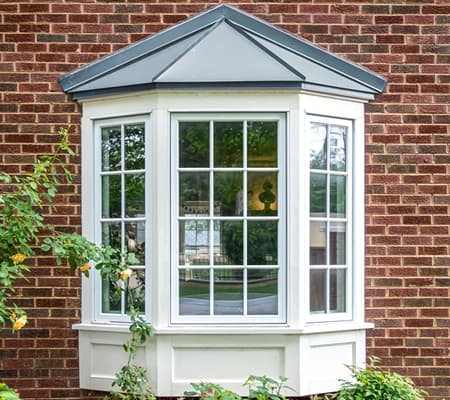
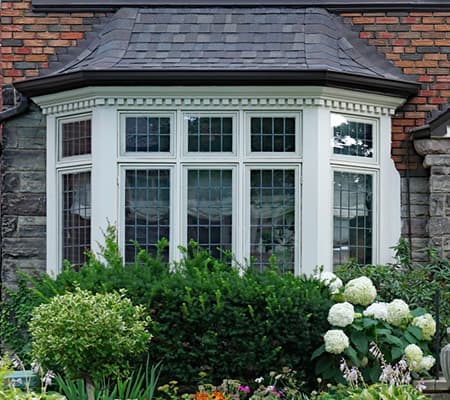
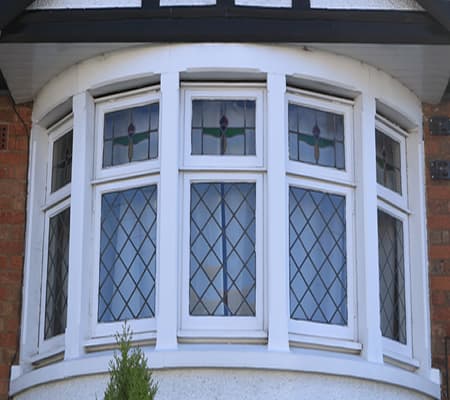
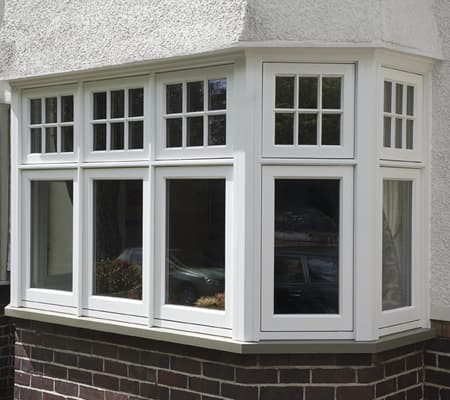
2.2 Square bay windows
Square bay windows, a.k.a rectangular or “box” bay windows are made of three sections, with the centre section usually (but not always) being wider than the others. The uniting trait of square bay windows is that the two side sections lie at right angles to the main middle section.
If you need to buy square bay window blinds, the good news for you is that measuring up for them is a bit more straightforward than it is for angled bay windows, which you can see for yourself here in our square bay window measuring guide.
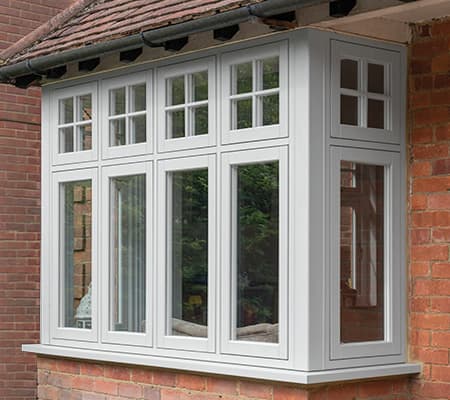
2.3 Oriel bay windows
Angled and square bay windows together make up the majority of bay windows in UK homes; but one of the other types of bay windows that are reasonably common here are oriel bay windows.
These are the type of bay window that don’t run right down to the floor itself, but stop at what most of us would think of as being at around normal windowsill height for a waist-height window. How many sections these are made up of can vary, and the number of sections and angles between them is the main thing that you need to factor in when choosing blinds.
2.4 Triangular bay windows
Finally, perhaps the least common of the common bay window types (oxymorons-r-us) are triangular bay windows. These are simply another type of oriel bay windows (in that they don’t run to floor level in the room in question) but are made up of just two sections/panels that lie at 90 degrees to each other to form a triangle-shaped protrusion from the side of the house.
These tend to be the smallest type of bay windows.
If you still can’t quite pinpoint what type of bay windows you have or are confident that it is a different type entirely – well sorry, no bay window blinds for you.
Ok, kidding. Give me a shout with some pictures, measurements, and any other info you think might be useful and I’ll set my flying monkeys loose to get a definitive answer on what type of bay windows they are and what type of blinds would work well on them.
3. Why the angle of the corners is important when deciding which blinds are best for bay windows
The main point to my explaining about the different types of bay windows you might encounter on your quest for blinds is that the sections of different types of bay windows meet at angles of varying degrees of acuteness.
The angle between the two sections of a triangular bay window and the sections of a square bay window respectively will almost certainly be 90 degrees; while for angled bay windows and most types of oriel bay windows, it will be somewhat shallower.
The more acute or sharp the angle, the more likely this is to be a potential problem with the fit or function of certain types of blinds, due to the way they meet, particularly at the top where the headrail and mechanism are and potentially, where the controls for them lie too.
The gentler the angle between window sections, the smaller any gaps between the blinds where they meet each other will be.
However, sharp angles don’t necessarily mean that some types of blinds are off the table entirely if you want to avoid gaps; because your sharp corners might in their turn be mitigated by your mullions.
4. How do mullions affect what blinds are best for bay windows? (Also, what are mullions?)
Mullions? Yeah I had no clue what they were either until I started working for English Blinds, and people started looking to me as if I was a designated grownup to whom questions about windows could confidently be addressed.
What are mullions? Mullions are the vertical bits of wood/uPVC/other material between the frame of your window and the glass; the bit that holds said glass into said frame and makes it look neat. The width of these can vary considerably, and this itself may be a defining factor in your being able to rule in or rule out any given blind for a bay window.
If you have wide mullions at the sides of each section of your window, you have a wider range of options on blind types that won’t result in gaps in the corners where the blinds meet.
This is because wide mullions are more forgiving in terms of covering gaps between the edge of the blind and the frame of the window; and give you more room to play with between the blind it adjoins on the next section over.
If you have narrow mullions, you may also have narrower options of blind types before gaps at the sides of your blinds start sneaking in. This is because certain types of blinds are more likely to result in a little gap or chink showing at the side of narrow mullions due to the room needed for the two headrails of blinds in bay windows and how they meet in the corner of it.
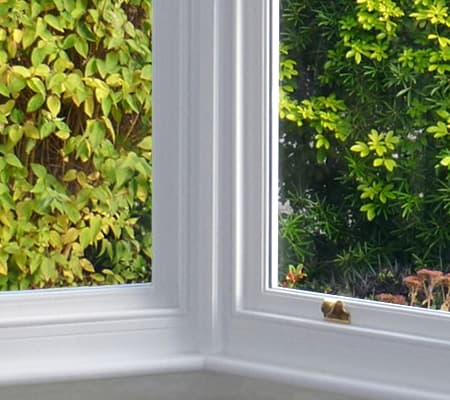
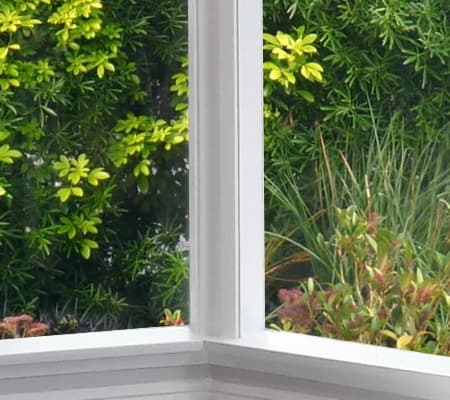
5. Window handles and their relevance (thereby completing the triad of bay window blind challenges)
Corner angle and mullion. These are the two most important things to remember when deciding which blinds are best for a bay window of a certain type, but there is one more thing I need to mention too before I let you loose picking out fabrics and finishes.
Window handles. Some (but not all) opening/closing mechanisms on windows stick out in the form of handles, and how far they stick out will also influence how snugly into the corner of each section your bay window blinds will fit.
This is because when you hang your blinds, you need to be sure that you hang them at a far enough protrusion/depth from the window frame itself to ensure that the blinds don’t hit the handles when the blind is raised and lowered.
This in turn then, potentially worsens or even introduces the possibility of gaps, and yes, I am sure you are now muttering to yourself “I swear if she says “gaps” one more time or comes up with another potential cause of them for me to deal with, I’m getting curtains…”
6. What blinds are best for a bay window to achieve the smallest possible gaps?
So then. If your bay window has either shallow angles between sections, generous mullions, or both, there’s a good chance that any type of blind will be fine in terms of not introducing gaps.
If that sounds like your window, the question of what blinds are best for a bay window in your own home can be answered simply by deciding on the appearance you want to achieve and what sort of light blocking/filtering abilities you want the blind to possess.
However, if you’re working with a gnarly corner angle between bay window sections, narrow mullions, sticky-outy-window handles or all three and you don’t want gaps, some blinds will be a far better choice than others.
The best blinds for a bay window with angle/mullion/handle issues in order to achieve the smallest possible gaps at the sides are, in order:
- 25mm Venetian (aluminium) blinds.
- Pleated blinds
- Roman blinds
- 25mm real wood Venetian blinds
- 35mm faux-wood Venetian blinds
- 35mm wooden Venetian blinds
- 50mm faux-wood Venetian blinds
- 50mm wooden Venetian blinds
- Vertical Blinds** (see footnote)
- Day and night blinds or zebra blinds
- Roller blinds
** Going back to vertical blinds for a bay window and their position fairly down the suitability list if you have sharp angles and/or narrow mullions, the gaps to the side can sometimes be reduced if your vertical blinds are manufactured in a certain way in order to achieve this.
Essentially, if the last louvre (fabric strip) at each end of the blind extends a shade past the width of the headrail of the blind, it will seamlessly cover any gap that would otherwise be there.
However, while you’re more than welcome to ask us about this and we will do our best to help, it’s not always possible to action, depending on how many louvres there are on each individual blind in your bay window array. This type of workaround definitely won’t be possible if you buy readymade vertical blinds either!
7. How much does it cost to fit blinds in a bay window?
“How much does it cost to fit blinds in a bay window” is a question in two parts, really; encompassing the purchase price of your bay window blinds themselves and then how much it costs to get them fitted.
The cost of the blinds themselves depends on the blind, and we can point you firmly down the right path in terms of how much you might expect to pay for blinds in the UK in this blog post. Obviously a bay window needs more blinds to cover it than a flat window will, so use that post to get a ballpark on window blind prices and then multiply accordingly.
Covering specifically how much does it cost to fit blinds in a bay window, today’s modern made-to-measure bay window blinds are designed for you as the householder to fit/hang yourself, without the need to hire someone or to get any specialist tools in.
This is honestly not hard, and all of our bay window blinds come complete with simple and easy-to-follow instructions on how to fit them. I promise. Even I can do it (on my own) and if you knew me, well, that statement would absolutely sell itself, trust me.
8. CAN I ACTUALLY JUST PICK SOME BLINDS NOW THOUGH? (Style and functional considerations)
If you’ve stuck with me this far, firstly, well done. Actually writing this guide made my head hurt a tiny bit (or that may have been the wine from last night) and I’m sure that you had any number of more fun things on your list you could have done other than reading it too.
However, you’ve made the right decision by doing so, because now you can make a sound choice on what blinds are best for a bay window you own, and avoid the pitfalls that your rather more devil-may-care significant other might have fallen in to if you’d supported their initial lament of “I’m not reading that, it’s massive, just get the Orla Kiely roman blinds like I said, it’ll be fine!”
We are now done with the cautions, caveats, and complications of picking blinds for a bay window, and onto the good part; choosing a style.
This is down to you in the main. It depends on the look you want to achieve in terms of the blind type and the finish of the design or fabric, as well as the sort of functions that might be particularly important to you, like being able to filter light without blocking it or alternatively, hermetically sealing your room in perfect darkness for a cheeky afternoon on Call of Duty.
To finish us off then, I’ll look at the various different types of blinds you can potentially have in a bay window, covering some pros and cons for each of them when it comes to bay windows of different types.
9. Can you have wooden blinds or faux-wood blinds in a bay window?
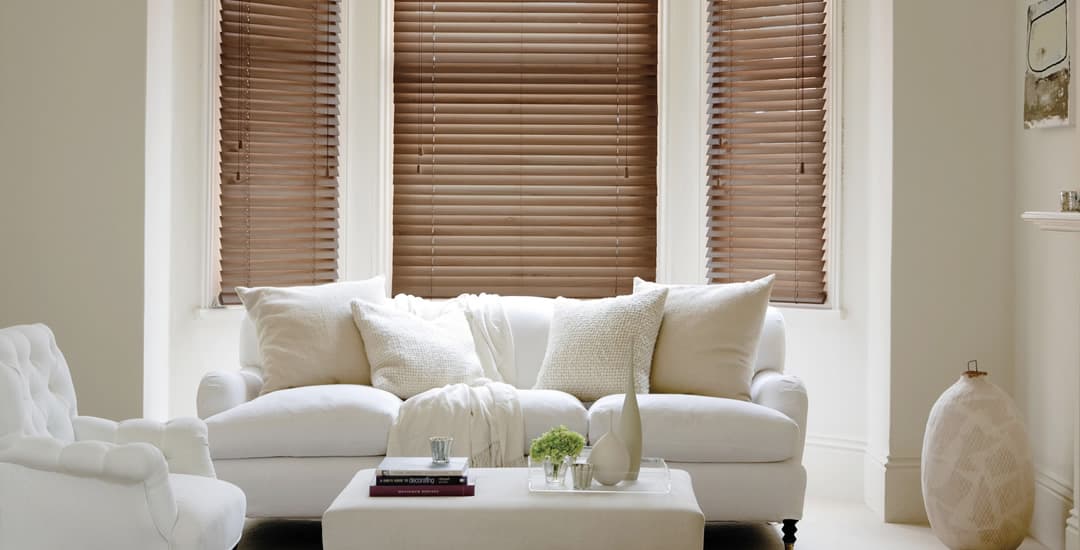
Yes, real wood blinds and faux wood blinds alike are popular styles of blinds for bay windows. Faux-wood and wooden blinds with smaller slats (the smallest being 25mm and 35mm respectively) will fit without gaps in all but the most acutely angled and narrowest mullioned of bay windows.
If you pick white wood/faux-wood blinds, they emulate a plantation shutter type of effect that is hugely popular in bay windows, but very costly to achieve with actual shutters!
One caveat to note though is that if you have bay windows with narrow mullions and/or more acute angles between sections, proceed with caution with wider slat sizes than those mentioned above if you want to avoid a gap.
If you want to find out more about wooden blinds and faux-wood blinds in general, such as the sort of colours and finishes they come in, how they are operated, what they do, and their benefits, check out this post covering pretty much everything you need to know about wooden blinds, and this post covering the same sort of info for faux-wood blinds too.
10. Can you have Venetian blinds in a bay window?
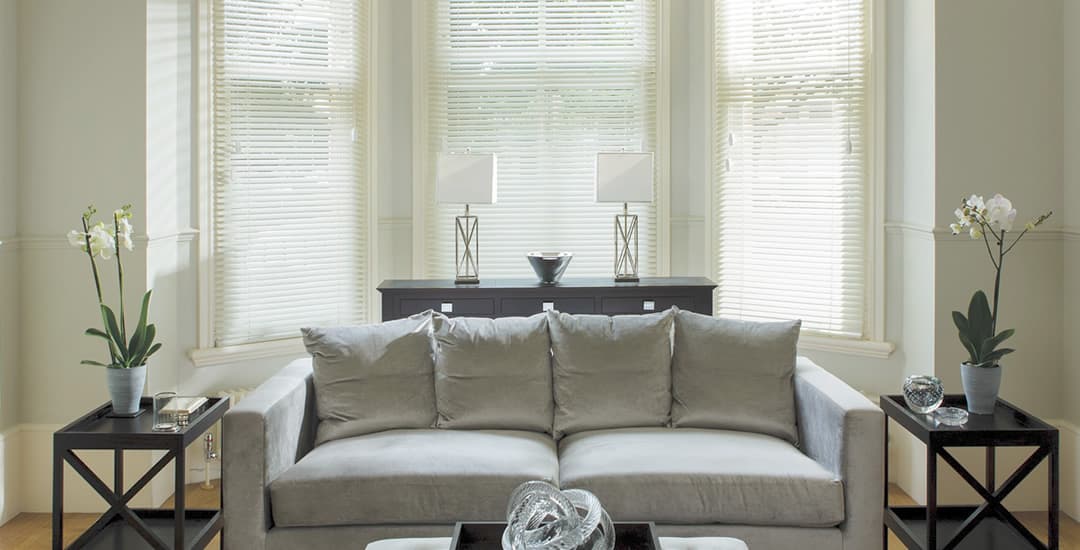
Yes, Venetian blinds (the aluminium type) offer lots of options for how you control your privacy and filter natural light. Aluminium Venetian blinds are also the most versatile bay window blinds, as they’re the blinds that will produce the smallest of gaps (or no gaps at all) in bay windows with acute angles and/or narrow mullions, giving a snug fit in the corners.
This alone makes bay window Venetian blinds a good choice if your windows are likely to be difficult to wrangle with wider-slatted blinds. They also take up less room on the windowsill in terms of their depth when lowered, and they form a small, narrow stack at the top when open, so they don’t cut into the view or reduce light to any great extent, even on smaller windows.
Venetian blinds help to deflect sun when closed, and they’re easy to clean and care for too as they’re water resistant.
Finally, you can pick which side of the blind you’d like the controls to be on, which can help you to avoid potential problems like tangling in window handles, or having to stretch to reach them in deeper windows. For more general info on cleaning and caring for Venetian blinds, take a look here.
11. Can you have pleated blinds in a bay window?
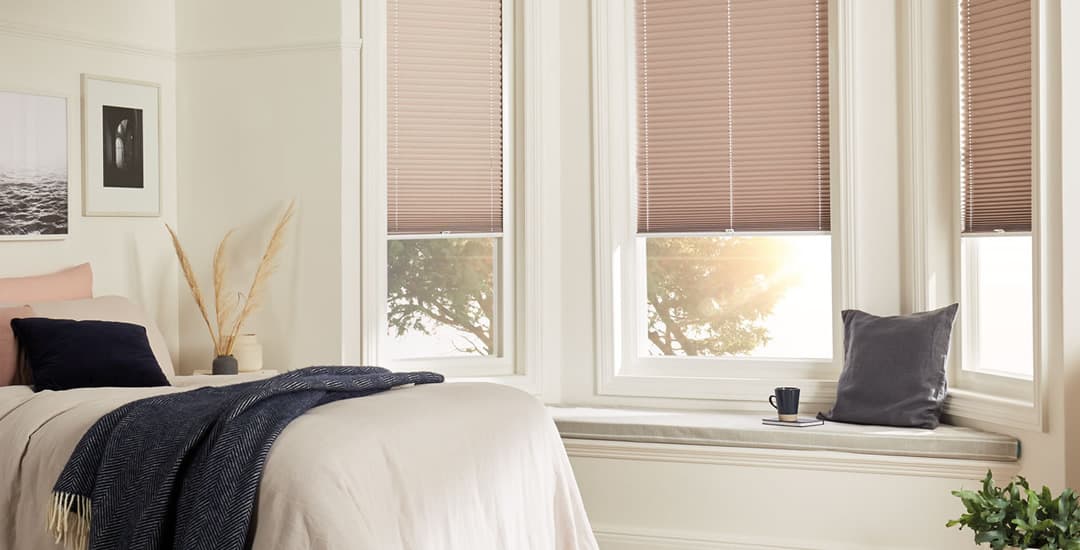
Pleated blinds are relatively new in the UK, which means that many would-be buyers have never heard of them and don’t know what they are; and one of the things that they are very good for is bay windows. Pleated blinds have a very slim profile, producing both a super-neat appearance and meaning that they will fit snugly into even the most narrowly mullioned or acutely angled of bay window corners without gaps.
Basically, however awkward your bay window is, pleated blinds can deal with its weirdness and any unusual or difficult shapes and angles you may have to factor in.
They’re also really lightweight, which leaves them on the table for large, wide, or tall windows where the weight of the blind itself is a significant deciding factor that may narrow down your other choices.
Pleated blinds can be made without cords too, meaning that pleated blind child safety is a no-brainer. This benefit also negates the issue of deciding where to place the cords, and potential conflicts with window handles or needing arms like Betty Spaghetti to be able to reach into the window recess to grab them.
Another advantage of pleated blinds for bay windows is that their honeycomb fabrics trap air, giving them a real lead in the thermal insulating stakes. This is even more important on multi-sided windows like bay windows, which of course can result in significant heat loss given the sheer surface area of their glass. Pleated blinds can also be made in fabrics with a special solar coating that reflects sunlight back and reduces overheating during the summer.
12. Can you have Roman blinds in a bay window?
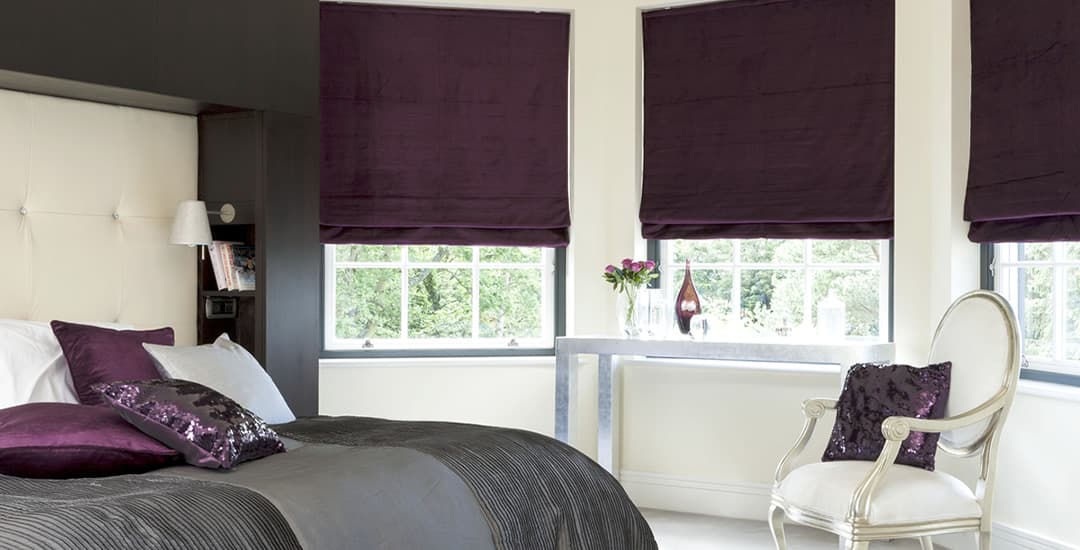
Yes, and again this is one of the go-to staples for many people looking for bay window blinds. Rooms that have bay windows tend to be on the larger side, and are often within very elegant homes, which means that Roman blinds are definitely an option to consider.
They have a narrow depth profile and so fit snugly into bay window corners, even those at an acute angle or with narrow mullions, and they also provide excellent insulation on larger windows of all types.
Bay window Roman blinds for lounges immediately come to mind for most people, as this will tend to be the room we spend the most of our downtime in and are most interested in making into a great-looking space.
Roman blinds for bedrooms are a sound choice too, and can easily be made with blackout linings; and their double-layered fabric also helps to reduce the impact of external noise when you’re sleeping.
If you’re wondering how to care for Roman blinds and if they’re a pain to clean, particularly if you have three or more of them in a bay window, this blog post will tell you more.
13. Can you have vertical blinds in a bay window?
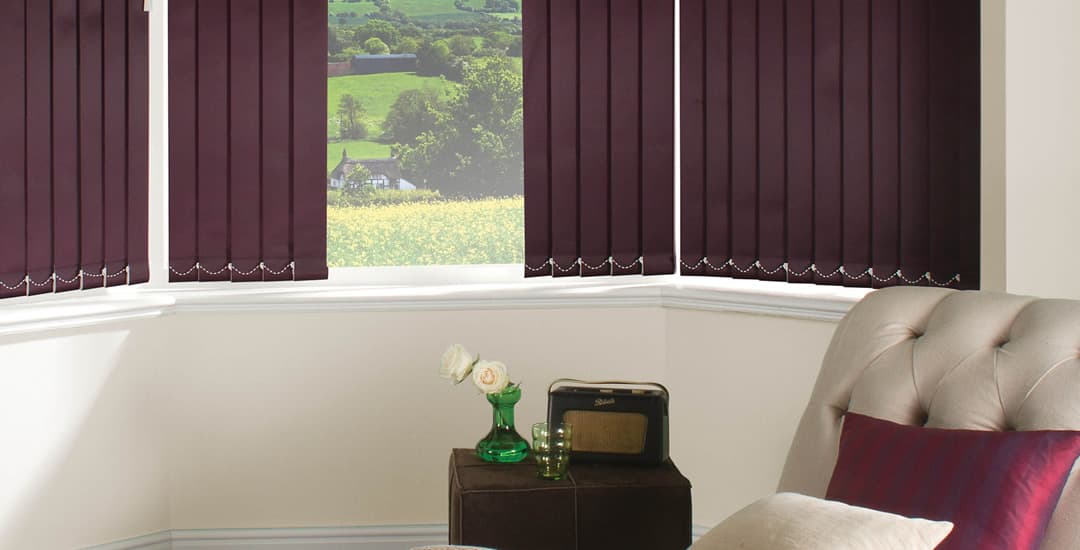
Yes, vertical blinds are a frequent flier in the shopping cart of bay window blind buyers, for a few reasons. They offer full control over light and privacy thanks to their tiltable louvres, and can be made really long and/or really wide, both of which are fair descriptions of many types of bay windows in their turn.
You can pick where to place the controls for vertical blinds and also where the louvres sit when the blind is open; thereby avoiding the side with handles on the window, or the need to contort yourself into a deep window recess to reach them.
Vertical blinds can be opened/closed to the left, right, or both (so that they part like curtains) and this on its own makes vertical blinds good for bay windows.
Most folk who choose vertical blinds for bay windows have the stack of louvres fall on the left on the left-hand window, the right on the right-hand window, and on both sides by means of the stack splitting in the middle on the centre window, creating a symmetrical appearance that “sparks joy” way more than you’d rightfully think it should. 😊
Ok, but can you have vertical blinds in a bay window with narrow mullions or acute angles?
Firstly, I am delighted to learn that you were paying attention earlier on when I talked about what blinds are best for a bay window to achieve the smallest possible gaps. As you may recall (or just to gloss over my former statement if you came straight here from the “contents” menu) I did rank vertical blinds for a bay window fairly low on the list if you may be facing gap issues.
Just to reiterate then, in many cases you can request that your vertical blinds maker produce your blinds with the final louvre on each end extending a touch past the width of the headrail, negating any otherwise-present gaps seamlessly.
If you want to find out a bit more about vertical blinds in general and hear my very convincing pitch for why you should get the outdated stereotype of verticals being plain office blinds out of your mind, click here. (P.S, they’re also one of the cheapest bay window blind types too).
14. Can you have roller blinds in a bay window?
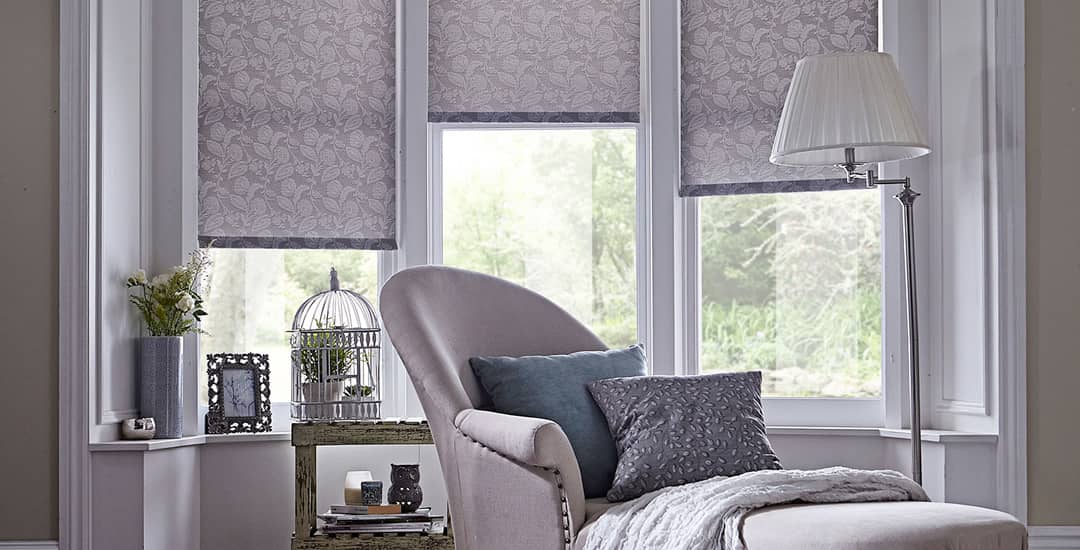
Yes, roller blinds work well in many types of bay windows; with the important caveat that roller blinds are the least well-suited option for bay windows with narrow mullions and acute corner angles if you want to avoid gaps.
Also, if you have protruding handles on your bay windows, you may want to ask for your roller blinds to be made so that they roll from the front of the tube not the back, to provide sufficient clearance for the handles. However, this in turn places the blind further out from the window than the norm, which can worsen the appearance of any otherwise-small gaps that might show at the corners.
These points are worth mentioning if you have windows with protruding handles and/or very narrow mullions and/or sharp angles at the corners of your bay window or all three, but if those points aren’t an issue, roller blinds are just as viable (and gap-free) an option as any other type of blinds for bay windows.
In fact, bay window roller blinds are particularly popular as roller blinds come in the widest range of colours and designs, and can be made in either dim-out or blackout fabrics depending on what you want to achieve light-wise.
Also, given that a bay window is fairly pricey to clothe just because you need more blinds for it than you would for a regular flat window, it may be worth mentioning that roller blinds tend to be the most cost-effective/cheapest type of blind overall.
15. Can you have day and night blinds in a bay window?
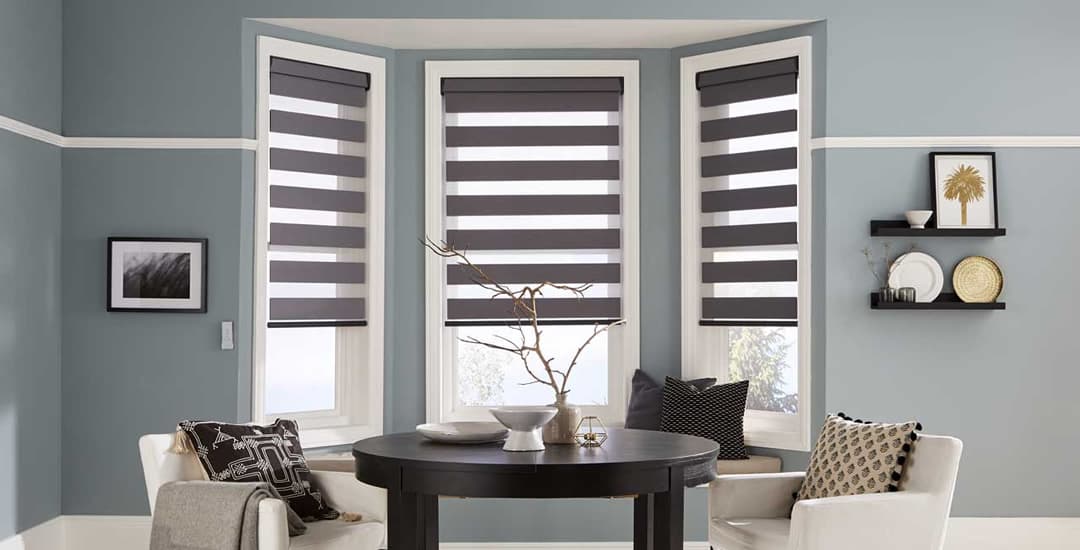
Finally, day and night blinds are not hugely common in the UK, but they’re fast becoming very popular. Day and night blinds are a type of roller blind, albeit one that has a wider repertoire of light and privacy filtering options, twice the fabric, and slightly less of a potential gapping issue on narrow-mullioned or acutely angled bay window corners.
That said, please bear in mind that they do still fall towards the bottom of the ranking in terms of suitability for bay windows with narrow mullions and/or acute corner angles.
If you want to know a bit more about day and night blinds in general click here; and if you don’t have particularly acutely angled or narrowly mullioned bay windows, consider day and night blinds for bay windows to be a perfectly viable choice.
If you’re not sure how risky day and night blinds for bay windows might be given any potential gap challenges your own window has and want to sound me out before you order, drop me a line.
You can also email me if you have any other questions about blinds for bay windows in general, and want to make sure you’ve thought of everything before going ahead with a purchase.




